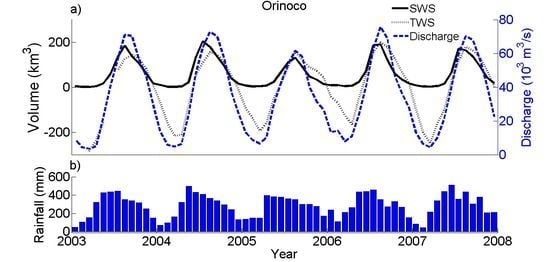Surface Freshwater Storage Variations in the Orinoco Floodplains Using Multi-Satellite Observations
Abstract
:1. Introduction
2. Datasets and Methods
2.1. Datasets
2.1.1. GIEMS
- (1)
- Advanced Very High Resolution Radiometer (AVHRR) visible (0.58–0.68 μm) and near-infrared (0.73–1.1 μm) reflectances and the derived Normalized Difference Vegetation Index (NDVI) [37].
- (2)
- Passive microwave emissivities between 19 and 85 GHz, estimated from the Special Sensor Microwave/Imager (SSM/I) observations by removing the contributions of the atmosphere (water vapor, clouds, rain) and the modulation by the surface temperature [38], as well as incorporating ancillary data from the International Satellite Cloud Climatology Project (ISCCP) [39] and the National Centers for Environment Prediction (NCEP) reanalysis [40].
- (3)
2.1.2. Envisat RA-2 Radar Altimeter-Derived Water Levels
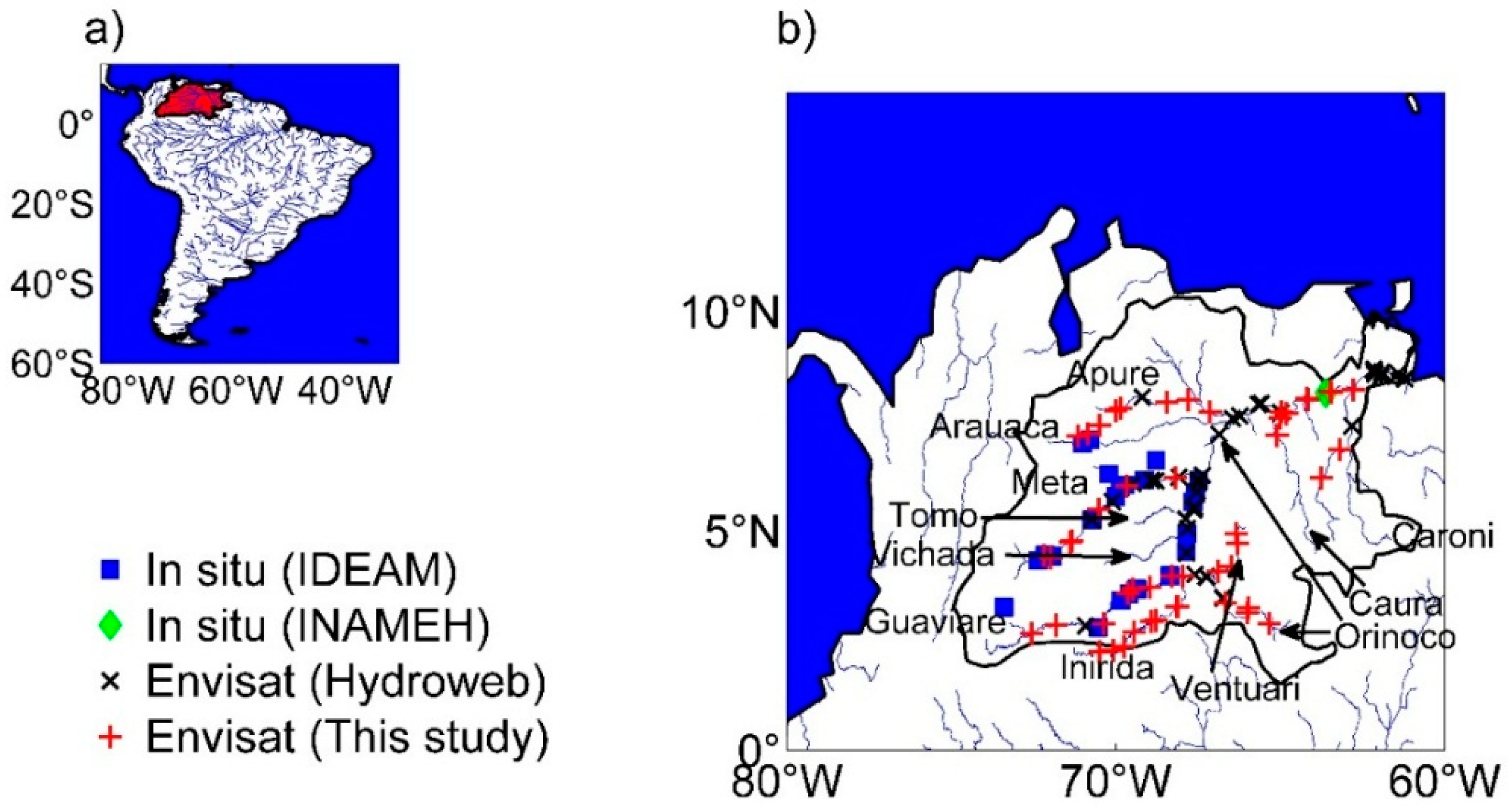
2.1.3. TRMM 3B43 Monthly Rainfall
2.1.4. 10-Day GRACE Regional Solutions
2.1.5. In Situ Water Levels and Discharges
| In Situ Station | River | Longitude (°) | Latitude (°) | Source | Availability during Validation Period |
|---|---|---|---|---|---|
| Ciudad Bolivar | Orinoco | −63.608 | 8.144 | INAMEH | 2002–2010 |
| Puerto Carreno | Orinoco | −67.467 | 6.167 | IDEAM | 2002–2010 |
| Puerto Nariño | Orinoco | −67.833 | 4.950 | IDEAM | 2002–2010 |
| Roncador | Orinoco | −67.567 | 5.850 | IDEAM | 2002–2010 |
| Casuarito | Orinoco | −67.633 | 5.667 | IDEAM | 2002–2003 |
| Mataven | Orinoco | −67.850 | 4.533 | IDEAM | 2002–2003 |
| Puerto Fortuna | Meta | −68.767 | 6.613 | IDEAM | 2002–2010 |
| Patevacal | Meta | −69.117 | 6.167 | IDEAM | 2002–2003 |
| Aguaverde | Meta | −69.983 | 5.783 | IDEAM | 2002–2003 |
| Puerto Texas | Meta | −71.917 | 4.433 | IDEAM | 2002–2003 |
| Santa Maria | Meta | −70.717 | 5.267 | IDEAM | 2002–2010 |
| Peregrino Paraiso | Meta | −69.717 | 6.050 | IDEAM | 2002–2003 |
| San Jorge | Meta | −69.850 | 6.000 | IDEAM | 2002–2003 |
| La Poyata | Meta | −72.150 | 4.450 | IDEAM | 2002–2003 |
| Humapo | Meta | −72.350 | 4.333 | IDEAM | 2002–2003 |
| Cravo Norte | Meta | −70.200 | 6.300 | IDEAM | 2002–2003 |
| Puerto Lleras | Meta | −73.383 | 3.267 | IDEAM | 2002–2008 |
| Sapuara | Guaviare | −69.350 | 3.683 | IDEAM | 2002–2003 |
| Puerto Nuevo | Guaviare | −69.833 | 3.417 | IDEAM | 2004–2010 |
| Cejal | Guaviare | −68.350 | 3.983 | IDEAM | 2002–2010 |
| Mapiripan | Guaviare | −70.533 | 2.800 | IDEAM | 2002–2003 |
| Barranco | Guaviare | −69.589 | 3.572 | IDEAM | 2003 |
| Angelitos | Arauaca | −71.000 | 7.000 | IDEAM | 2002–2005 |
| Ponte Internacional | Arauaca | −70.767 | 7.083 | IDEAM | 2002–2010 |
| Santa Rita | Vichada | −67.983 | 4.867 | IDEAM | 2003–2010 |
2.2. Methods for Estimating Surface Water Storage
2.2.1. Monthly Maps of Surface Water Levels
2.2.2. Time Series of Water Volume Variations
3. Results
3.1. Temporal Variations of Flood Extent
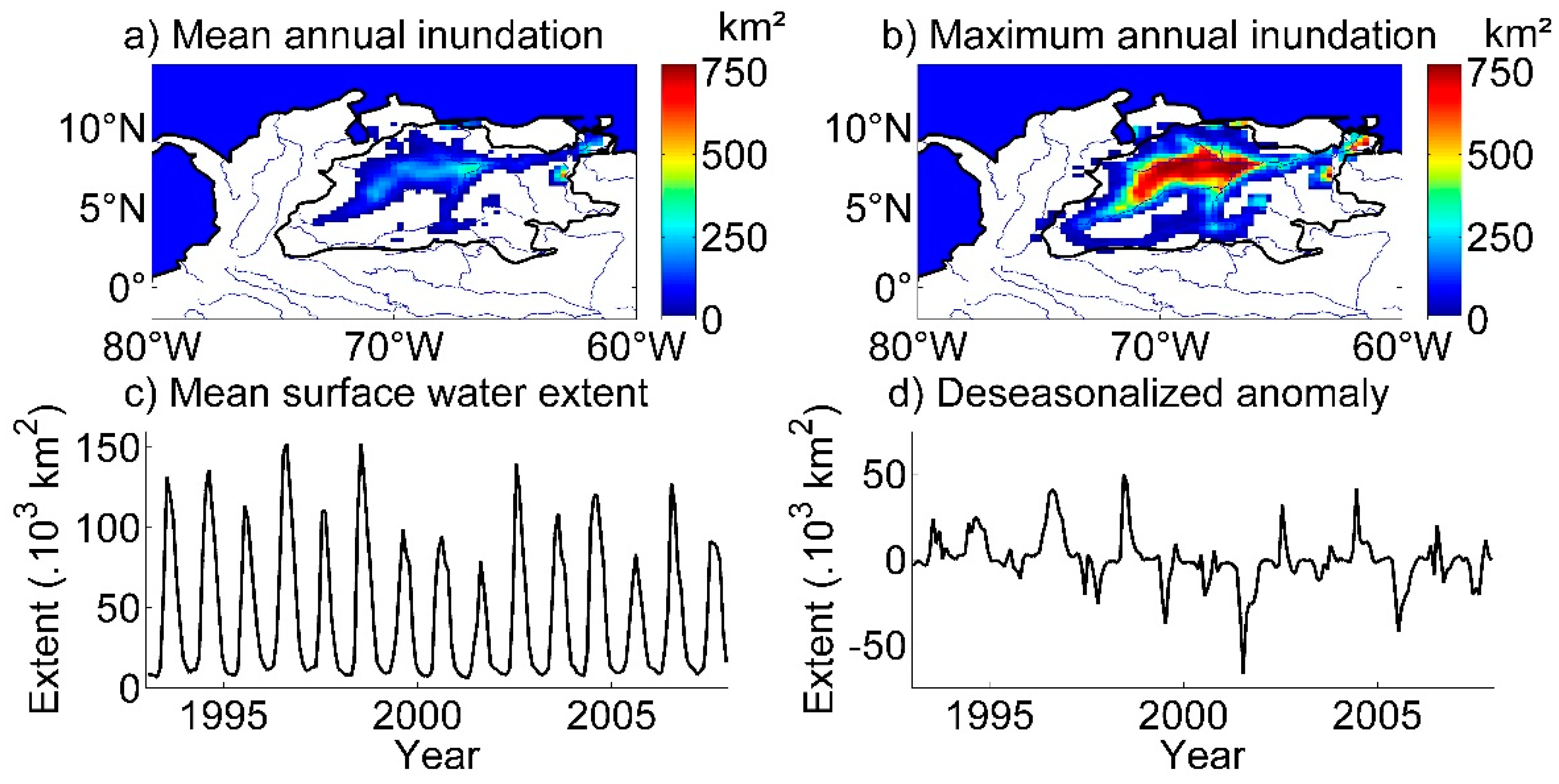
3.2. Validation of Altimetry-Based Water Levels
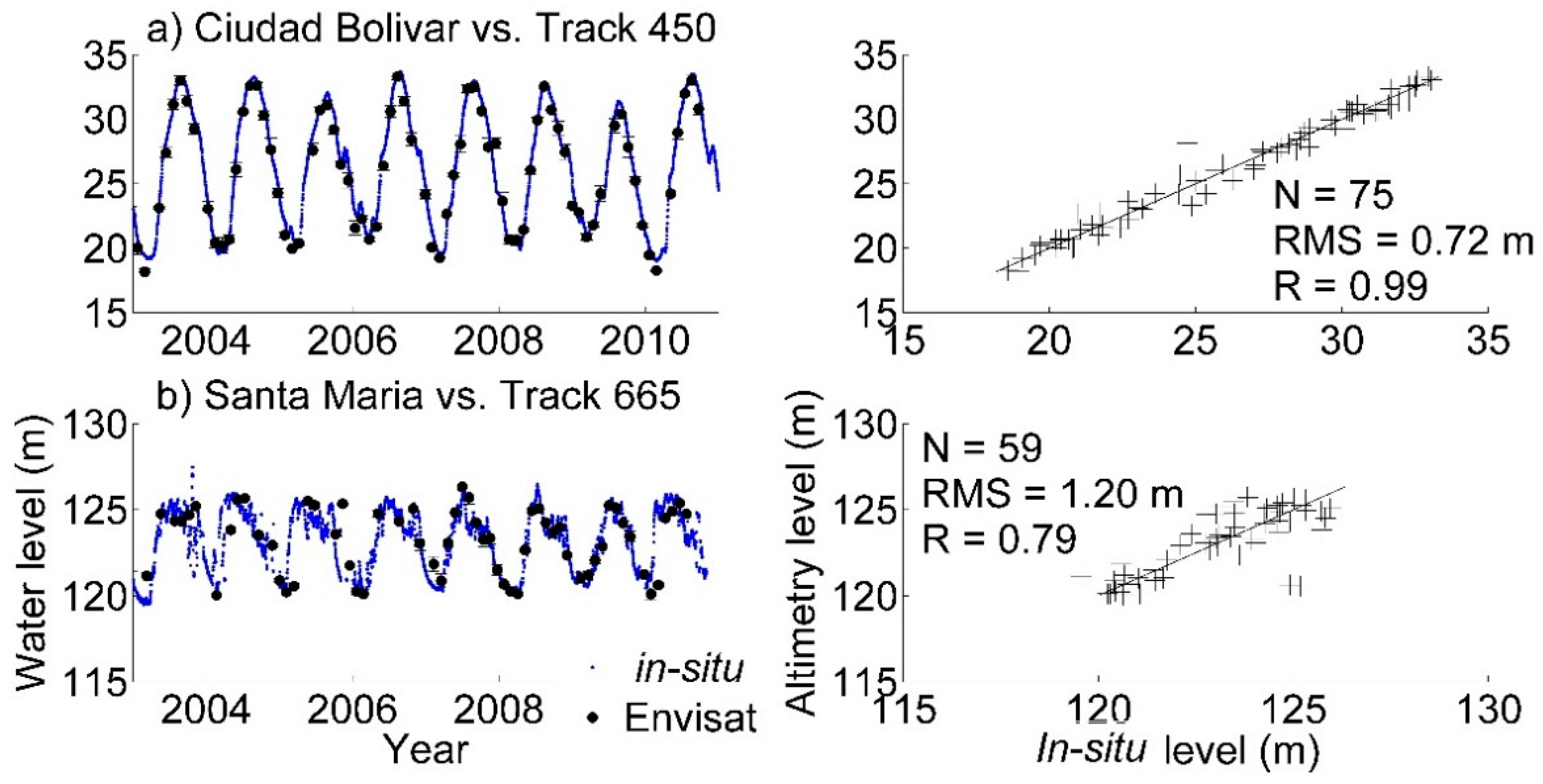
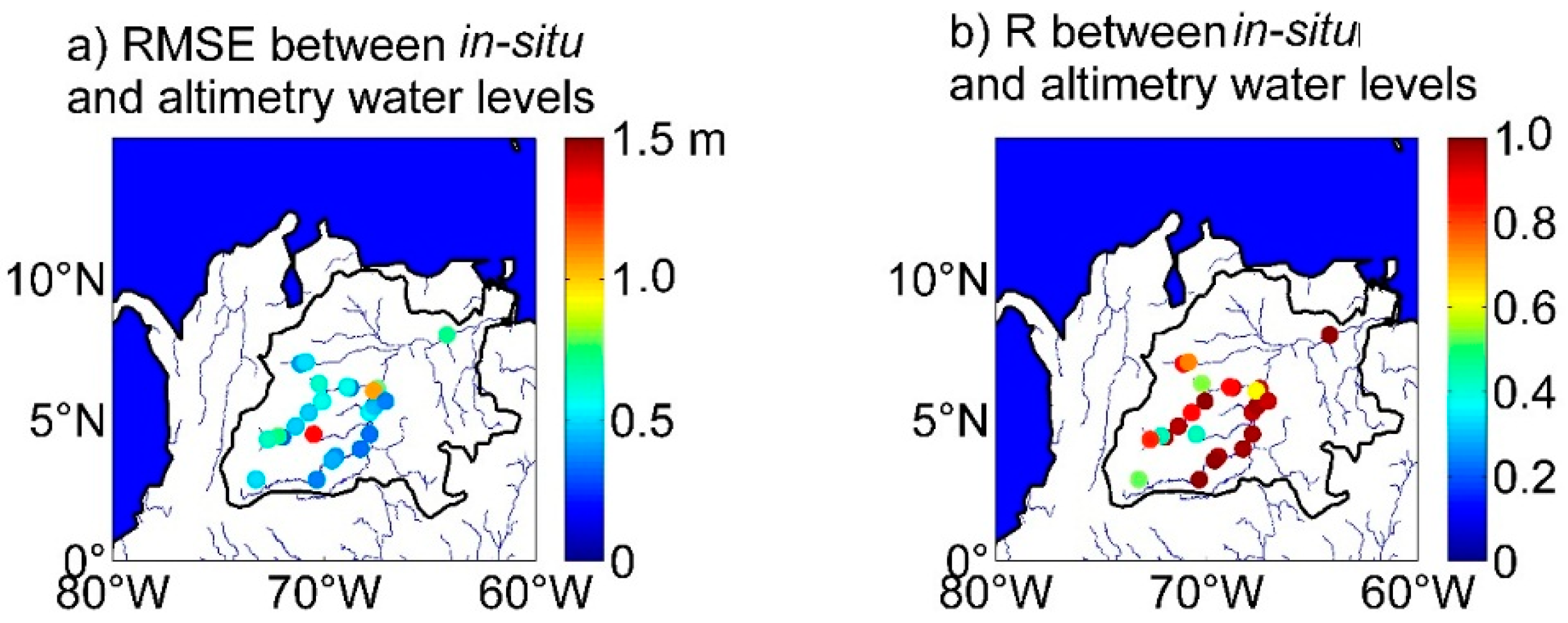

3.3. Time Variations of Surface Water Storage in the Orinoco Floodplains

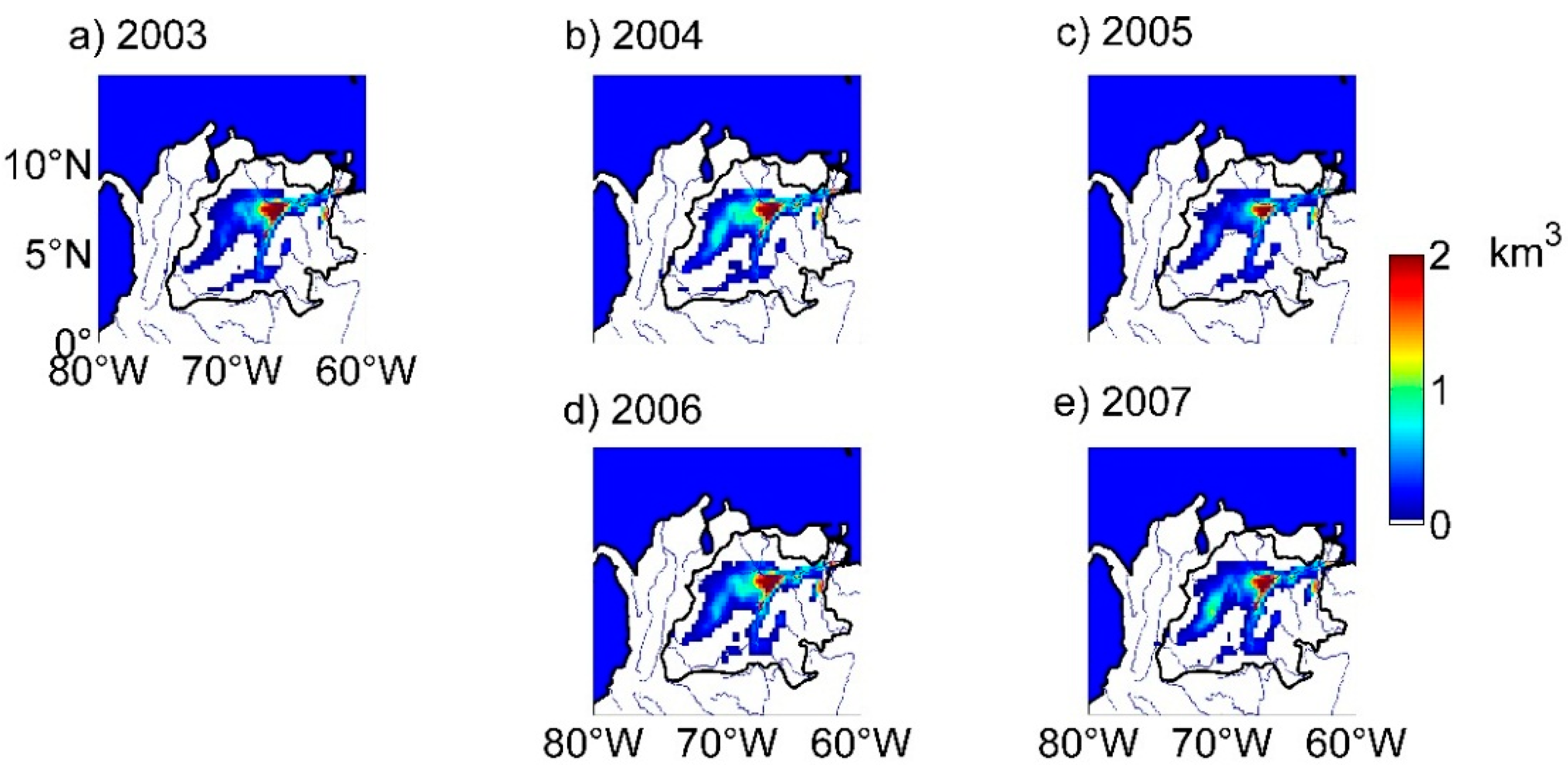
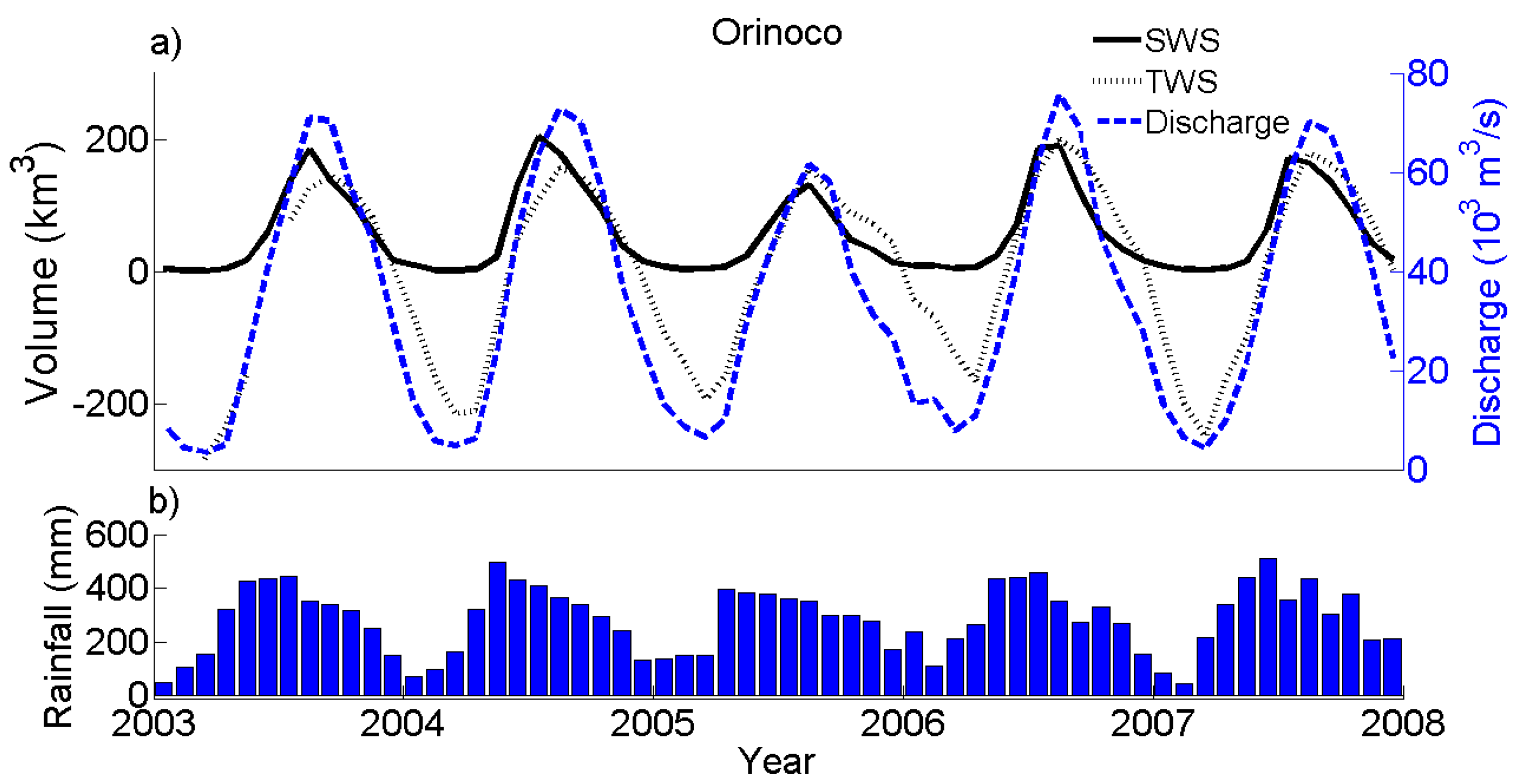
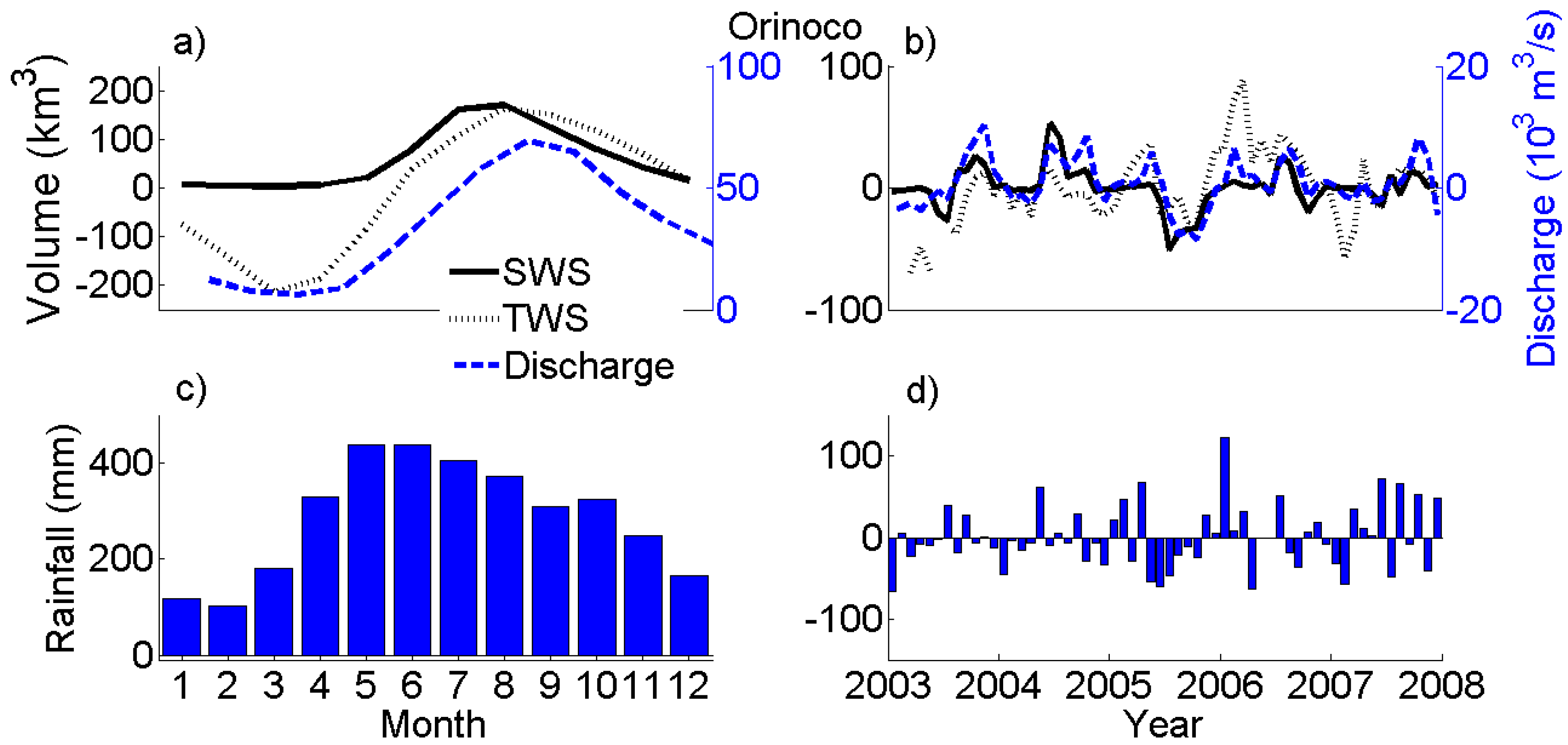
4. Summary and Conclusions
Acknowledgments
Author Contributions
Conflicts of Interest
References
- Chahine, M. The hydrological cycle and its influence on climate. Nature 1992, 359, 373–380. [Google Scholar] [CrossRef]
- Kundzewicz, Z.W.; Mata, L.J.; Arnell, N.W.; Döll, P.; Kabat, P.; Jiménez, B.; Miller, K.A.; Oki, T.; Sen, Z.; Shiklomanov, I.A. Freshwater resources and their management. In Climate Change 2007: Impacts. Adaptation. and Vulnerability. Contribution of Working Group II to the Fourth Assessment Report of the Intergovernmental Panel on Climate Change; Parry, M.L., Canziani, O.F., Palutikof, J.P., van der Linden, P.J., Hanson, C.E., Eds.; Cambridge University Press: Cambridge, UK, 2007; pp. 173–210. [Google Scholar]
- Maltby, E. Wetland management goals: Wise use and conservation. Landsc. Urban Plan. 2003, 20, 9–18. [Google Scholar] [CrossRef]
- Bullock, A.; Acreman, M. The role of wetlands in the hydrological cycle. Hydrol. Earth Syst. Sci. 2003, 7, 358–389. [Google Scholar] [CrossRef]
- Organisation for Economic Cooperation and Development. Guidelines for Aid Agencies for Improved Conservation and Sustainable Use of Tropical and Sub-tropical Wetlands; Guidelines Aid Environment: Paris, France, 1996. [Google Scholar]
- Richey, J.E.; Melack, J.M.; Aufdenkampe, K.; Ballester, V.M.; Hess, L. Outgassing from Amazonian rivers and wetlands as a large tropical source of atmospheric CO2. Nature 2002, 416, 617–620. [Google Scholar] [CrossRef] [PubMed]
- Bousquet, P.; Ciais, P.; Miller, J.B.; Dlugokencky, E.J.; Hauglustaine, D.A.; Prigent, C.; van der Werf, G.R.; Peylin, P.; Brunke, E.-G.; Carouge, C.; et al. Contribution of anthropogenic and natural sources to atmospheric methane variability. Nature 2006, 443, 439–443. [Google Scholar] [CrossRef] [PubMed]
- Ringeval, B.; de Noblet-Ducoudré, N.; Ciais, P.; Bousquet, P.; Prigent, C.; Papa, F.; Rossow, W.B. An attempt to quantify the impact of changes in wetland extent on methane emissions at the seasonal and interannual time scales. Glob. Biochem. Cy. 2010, 24. [Google Scholar] [CrossRef]
- Decharme, B.; Douville, H.; Prigent, C.; Papa, F.; Aires, F. A new river flooding scheme for global climate applications: Off-line validation over South America. J. Geophys. Res. 2008, 113. [Google Scholar] [CrossRef]
- Azarderakhsh, M.; Rossow, W.B.; Papa, F.; Norouzi, H.; Khanbilvardi, R. Diagnosing water variations within the Amazon basin using satellite data. J. Geophys. Res. 2011, 116. [Google Scholar] [CrossRef]
- Frappart, F.; Ramillien, G.; Ronchail, J. Changes in terrestrial water storage versus rainfall and discharges in the Amazon basin. Int. J. Climatol. 2013, 33, 3029–3046. [Google Scholar] [CrossRef]
- Paiva, R.C.D.; Buarque, D.C.; Colischonn, W.; Bonnet, M.-P.; Frappart, F.; Calmant, S.; Mendes, C.A.B. Large-scale hydrological and hydrodynamics modelling of the Amazon River basin. Water Resour. Res. 2013, 49, 1226–1243. [Google Scholar] [CrossRef]
- Junk, W.J.; Bayley, P.B.; Sparks, R.E. The Flood-Pulse Concept in River-Floodplain Systems. Available online: http://swrcb2.swrcb.ca.gov/waterrights/water_issues/programs/bay_delta/bay_delta_plan/water_quality_control_planning/docs/sjrf_spprtinfo/junk_et_al_1989.pdf (accessed on 29 September 2014).
- Richey, J.E.; Mertes, L.A.K.; Dunne, T.; Victoria, R.L.; Forsberg, B.R.; Tancredi, C.; Oliveira, E. Sources and routing of the Amazon River flood wave. Glob. Biogeochem. Cy. 1989, 3, 191–204. [Google Scholar] [CrossRef]
- Mertes, L.A.K.; Daniel, D.L.; Melack, J.M.; Nelson, B.; Martinelli, L.A.; Forsberg, B.R. Spatial patterns of hydrology, geomorphology and vegetation on the floodplain of the Amazon River in Brazil from a remote sensing perspective. Geomorphology 1995, 13, 215–222. [Google Scholar] [CrossRef]
- Hamilton, S.K.; Sippel, S.J.; Calheiros, D.F.; Melack, J.M. An anoxic event and other biogeochemical effects of the Pantanal wetland on the Paraguay River. Limnol. Oceanogr. 1997, 42, 257–272. [Google Scholar] [CrossRef]
- Junk, W.J. The Central Amazon Floodplain: Ecology of a Pulsing System; Springer: Brelin, Germany, 1997. [Google Scholar]
- Alsdorf, D.E.; Smith, L.C.; Melack, J.M. Amazon floodplain water level changes measured with interferometric SIR-C radar. IEEE Trans. Geosci. Remote Sens. 2001, 39, 423–431. [Google Scholar] [CrossRef]
- Frappart, F.; Seyler, F.; Martinez, J.M.; León, J.G.; Cazenave, A. Floodplain water storage in the Negro River basin estimated from microwave remote sensing of inundation area and water levels. Remote Sens. Environ. 2005, 99, 387–399. [Google Scholar] [CrossRef]
- Hamilton, S.K.; Sippel, S.J.; Melack, J.M. Inundation patterns in the Pantanal wetland of South America determined from passive microwave remote sensing. Arch. Hydrobiol. 1996, 137, 1–23. [Google Scholar]
- Hamilton, S.K.; Sippel, S.J.; Melack, J.M. Comparison of inundation patterns among major South American floodplains. J. Geophys. Res. 2002, 107. [Google Scholar] [CrossRef]
- Hamilton, S.K.; Sippel, S.J.; Melack, J.M. Seasonal inundation patterns in two large savanna floodplains of South America: The Llanos de Moxos (Bolivia) and the Llanos del Orinoco (Venezuela and Colombia). Hydrol. Process. 2004, 18, 2103–2116. [Google Scholar] [CrossRef]
- Prigent, C.; Matthews, E.; Aires, F.; Rossow, W.B. Remote sensing of global wetland dynamics with multiple satellite datasets. Geophys. Res. Lett. 2001, 28, 4631–4634. [Google Scholar] [CrossRef]
- Prigent, C.; Papa, F.; Aires, F.; Rossow, W.B.; Matthews, E. Global inundation dynamics inferred from multiple satellite observations, 1993–2000. J. Geophys. Res. 2007, 112. [Google Scholar] [CrossRef]
- Bourrel, L.; Phillips, L.; Moreau, S. The dynamics of floods in the Bolivian Amazon Basin. Hydrol. Process. 2009, 23, 3161–3167. [Google Scholar] [CrossRef]
- Papa, F.; Prigent, C.; Rossow, W.B.; Matthews, E. Interannual variability of surface water extent at global scale. 1993–2004. J. Geophys. Res. 2007, 115. [Google Scholar] [CrossRef]
- Frappart, F.; Papa, F.; Famiglietti, J.S.; Prigent, C.; Rossow, W.B.; Seyler, F. Interannual variations of river water storage from a multiple satellite approach: A case study for the Rio Negro River basin. J. Geophys. Res. 2008, 113. [Google Scholar] [CrossRef]
- Frappart, F.; Papa, F.; Santos da Silva, J.; Ramillien, G.; Prigent, C.; Seyler, F.; Calmant, S. Surface freshwater storage and dynamics in the Amazon basin during the 2005 exceptional drought. Environ. Res. Lett. 2012, 7. [Google Scholar] [CrossRef]
- Papa, F.; Frappart, F.; Güntner, A.; Prigent, C.; Aires, F.; Getirana, A.C.V.; Maurer, R. Surface freshwater storage and variability in the Amazon basin from multi-satellite observations. 1993–2007. J. Geophys. Res. Atmos. 2013, 118, 11951–11965. [Google Scholar] [CrossRef]
- Meade, R.H.; Nordin, C.F.J.; Perez Hernandez, D.; Mejia, A.; Perez Godoy, J.M. Sediment and water discharge in Rio Orinoco, Venezuela and Colombia. In Proceedings of the Second International Symposium on River Sedimentation, Beijing, China, 11–16 October 1980.
- Silva Leon, G. The Orinoco River Basin: Hydrographic View and Its Hydrological Balance. Available online: http://www.saber.ula.ve/bitstream/123456789/24636/2/articulo4.pdf (accessed on 29 September 2014).
- Lewis, W.M., Jr.; Saunders, J.F., III. Concentration and transport of dissolved and suspended substances in the Orinoco River. Biogeochemistry 1989, 7, 203–240. [Google Scholar] [CrossRef]
- Hamilton, S.K.; Lewis, W.M., Jr. Physical Characteristics of the Fringing Floodplain of the Orinoco River, Venezuela. Available online: http://ciresweb.colorado.edu/limnology/pubs/pdfs/Pub110.pdf (accessed on 29 September 2014).
- Hamilton, S.K.; Lewis, W.M., Jr. Basin Morphology in Relation to Chemical and Ecological Characteristics of Lakes on the Orinoco River Floodplain. Venezuela. Available online: http://cires.colorado.edu/limnology/pubs/pdfs/Pub113.pdf (accessed on 29 September 2014).
- Prigent, C.; Papa, F.; Aires, F.; Jimenez, C.; Rossow, W.B.; Matthews, E. Changes in land surface water dynamics since the 1990s and relation to population pressure. Geophys. Res. Lett. 2012, 39. [Google Scholar] [CrossRef]
- Papa, F.; Prigent, C.; Durand, F.; Rossow, W.B. Wetland dynamics using a suite of satellite observations: A case study of application and evaluation for the Indian Subcontinent. Geophys. Res. Lett. 2006, 33. [Google Scholar] [CrossRef]
- Tucker, C.J. Red and photographic infrared linear combinations for monitoring vegetation. Remote Sens. Environ. 1979, 8, 127–150. [Google Scholar] [CrossRef]
- Prigent, C.; Aires, F.; Rossow, W.B. Land surface microwave emissivities over the globe for a decade. Bull. Am. Meteorol. Soc. 2006, 87, 1573–1584. [Google Scholar] [CrossRef]
- Rossow, W.B.; Schiffer, R.A. Advances in understanding clouds from ISCCP. Bull. Am. Meteorol. Soc. 1999, 80, 2261–2287. [Google Scholar] [CrossRef]
- Kalnay, E.; Kanamitsu, M.; Kistler, R.; Collins, W.; Deaven, D.; Gandin, L.; Iredell, M.; Saha, S.; White, G.; Woollen, J.; et al. The NCEP/NCAR 40-year reanalysis project. Bull. Am. Meteorol. Soc. 1996, 77, 437–470. [Google Scholar] [CrossRef]
- Armstrong, R.L.; Brodzik, M.J. Northern Hemisphere EASE-Grid Weekly Snow Cover and Sea Ice Extent Version 3; National Snow and Ice Data Center: Boulder, CO, USA, 2005. [Google Scholar]
- Papa, F.; Güntner, A.; Frappart, F.; Prigent, C.; Rossow, W.B. Variations of surface water extent and water storage in large river basins: A comparison of different global data sources. Geophys. Res. Lett. 2008, 35. [Google Scholar] [CrossRef]
- Birkett, C.M. The contribution of TOPEX/POSEIDON to the global monitoring of climatically sensitive lakes. J. Geophys. Res. 1995, 100. [Google Scholar] [CrossRef]
- Birkett, C.M. Contribution of the TOPEX NASA Radar Altimeter to the global monitoring of large rivers and wetlands. Water Resour. Res. 1998, 34, 1223–1239. [Google Scholar] [CrossRef]
- Frappart, F.; Calmant, S.; Cauhopé, M.; Seyler, F.; Cazenave, A. Preliminary results of ENVISAT RA-2 derived water levels validation over the Amazon basin. Remote Sens. Environ. 2006, 100, 252–264. [Google Scholar] [CrossRef]
- Frappart, F.; Do Minh, K.; L’Hermitte, J.; Cazenave, A.; Ramillien, G.; Le Toan, T.; Mognard-Campbell, N. Water volume change in the lower Mekong basin from satellite altimetry and imagery data. Geophys. J. Int. 2006, 167, 570–584. [Google Scholar] [CrossRef]
- Zelli, C. ENVISAT RA-2 advanced radar altimeter: Instrument design and pre-launch performance assessment review. Acta. Astronaut. 1999, 44, 323–333. [Google Scholar] [CrossRef]
- Hydroweb Database. Available online: http://www.legos.obs-mip.fr/en/soa/hydrologie/hydroweb (accessed on 3 January 2013).
- Virtual Altimetry Station Software, Version 0.6.2. Available online: www.mpl.ird.fr/hybam/outils/logiciels_test.php (accessed on 5 March 2013).
- Center for Topographic Studies of the Ocean and Hydrosphere. Available online: http://ctoh.legos.obs-mip.fr (accessed on 15 March 2013).
- Santos Da Silva, J.; Calmant, S.; Seyler, F.; Corrêa Rotunno Filho, O.; Cochonneau, G.; Mansur, W.J. Water levels in the Amazon basin derived from the ERS 2 and ENVISAT radar altimetry missions. Remote Sens. Environ. 2010, 114, 2160–2181. [Google Scholar] [CrossRef]
- Pavlis, N.K.; Holmes, S.A.; Kenyon, S.C.; Factor, J.K. The development and evaluation of the Earth Gravitational Model 2008 (EGM2008). J. Geophys. Res. 2012, 117. [Google Scholar] [CrossRef]
- Office of Geomatics: World Geodetic System 1984 (WGS 84). Available online: http://earth-info.nga.mil/GandG/wgs84/ (accessed on 15 March 2013).
- Tropical Rainfall Measuring Mission (TRMM) 3B43 v7 Product. Available online: http://disc.sci.gsfc.nasa.gov/precipitation/documentation/TRMM_README/TRMM_3B43_readme.shtml (accessed on 1 September 2014).
- Huffmann, G.J.; Adler, R.F.; Rudolf, B.; Schneider, U.; Keehn, P.R. Global precipitation estimates based on a technique for combining satellite-based estimates rain gauge analysis and NWP model precipitation information. J. Clim. 1995, 8, 1284–1295. [Google Scholar] [CrossRef]
- Huffmann, G.J.; Adler, R.F.; Bolvin, D.T.; Gu, G.; Nelkin, E.J.; Bowman, K.P.; Hong, Y.; Stocker, E.F.; Wolf, D.B. The TRMM multi-satellite precipitation analysis (TMPA): Quasi-global. multi-year combined-sensor precipitation estimates at fine scale. J. Hydrometeorol. 2007, 8, 38–55. [Google Scholar] [CrossRef]
- Goddard Earth Sciences Data and Information Services Center (GES DISC). Available online: http://daac.gscf.nasa.gov (accessed on 1 September 2014).
- Tapley, B.D.; Bettadpur, S.; Watkins, M.; Reigber, C. The gravity recovery and climate experiment: Mission overview and early results. Geophys. Res. Lett. 2004, 31. [Google Scholar] [CrossRef]
- Ramillien, G.; Biancale, R.; Gratton, S.; Vasseur, X.; Bourgogne, S. GRACE-derived surface mass anomalies by energy integral approach. Application to continental hydrology. J. Geodesy 2011, 85, 313–328. [Google Scholar] [CrossRef]
- Ramillien, G.; Seoane, L.; Frappart, F.; Biancale, R.; Gratton, S.; Vasseur, X.; Bourgogne, S. Constrained regional recovery of continental water mass time-variations from GRACE-based geopotential anomalies over South America. Surv. Geophys. 2012, 33, 887–905. [Google Scholar] [CrossRef]
- Frappart, F.; Seoane, L.; Ramillien, G. Validation of GRACE-derived water mass storage using a regional approach over South America. Remote Sens. Environ. 2013, 137, 69–83. [Google Scholar] [CrossRef]
- Frappart, F.; Papa, F.; Güntner, A.; Werth, S.; Santos da Silva, J.; Tomasella, J.; Seyler, F.; Prigent, C.; Rossow, W.B.; Calmant, S.; et al. Satellite-based estimates of groundwater storage variations in large drainage basins with extensive floodplains. Remote Sens. Environ. 2011, 115, 1588–1594. [Google Scholar] [CrossRef]
- Ramillien, G.; Frappart, F.; Cazenave, A.; Güntner, A. Time variations of land water storage from the inversion of 2-years of GRACE geoids. Earth Planet. Sci. Lett. 2005, 235, 283–301. [Google Scholar] [CrossRef]
- Aceituno, P. On the functioning of the Southern Oscillation in the South American sector. Part I: Surface climate. Mon. Weather Rev. 1988, 116, 505–524. [Google Scholar] [CrossRef]
- Marengo, J.A.; Nobre, C.A.; Tomasella, J.; Oyama, M.D.; Sampaio de Oliveira, G.; De Oliveira, R.; Camargo, H.; Alves, L.M.; Brown, I.F. The drought of Amazonia in 2005. J. Clim. 2008, 21, 495–516. [Google Scholar] [CrossRef]
- León, J.G.; Navarro, C.; Seyler, F. Monitoreo de la hidrografía colombiana mediante la implementación de estaciones virtuales ENVISAT. In Gestión Integrada del Recurso Hídrico Frente al Cambio Climático; Universidad Nacional de Colombia: Sede Palmira: Palmira, Colombia, 2010; pp. 401–410. [Google Scholar]
- León, J.G.; Seyler, F.; Puerta, A. Estimación de Curvas de gasto en Estaciones virtuales Envisat sobre el Cauce Principal del río Orinoco. Available online: http://www.revistas.unal.edu.co/index.php/ingeinv/article/view/26391/26726 (accessed on 29 September 2014).
- Santos da Silva, J.; Seyler, F.; Calmant, S.; Rotunno Filho, O.C.; Roux, E.; Araújo, A.A.M.; Guyot, J.L. Water level dynamics of Amazon wetlands at the watershed scale by satellite altimetry. Int. J. Remote Sens. 2012, 33, 3323–3353. [Google Scholar]
- Baup, F.; Frappart, F.; Maubant, J. Combining high-resolution satellite images and altimetry to estimate the volume of small lakes. Hydrol. Earth Syst. Sci. 2014, 18, 2007–2020. [Google Scholar] [CrossRef]
- Pfeffer, J.; Seyler, F.; Bonnet, M.-P.; Calmant, S.; Frappart, F.; Papa, F.; Paiva, R.C.D.; Satgé, F.; Silva, J.S.D. Low-water maps of the groundwater table in the central Amazon by satellite altimetry. Geophys. Res. Lett. 2014, 41, 1981–1987. [Google Scholar] [CrossRef]
- Fatras, C.; Frappart, F.; Mougin, E.; Grippa, M.; Hiernaux, P. Estimating surface soil moisture over Sahel using ENVISAT RA-2 altimetry measurements. Remote Sens. Environ. 2012, 123, 496–507. [Google Scholar] [CrossRef]
- Zeng, N.; Yoon, J.H.; Marengo, J.A.; Subramaniam, A.; Nobre, C.A.; Mariotti, A.; Neelin, J.D. Causes and impacts of the 2005 Amazon drought. Environment. Res. Lett. 2008, 3. [Google Scholar] [CrossRef]
© 2014 by the authors; licensee MDPI, Basel, Switzerland. This article is an open access article distributed under the terms and conditions of the Creative Commons Attribution license (http://creativecommons.org/licenses/by/4.0/).
Share and Cite
Frappart, F.; Papa, F.; Malbeteau, Y.; León, J.G.; Ramillien, G.; Prigent, C.; Seoane, L.; Seyler, F.; Calmant, S. Surface Freshwater Storage Variations in the Orinoco Floodplains Using Multi-Satellite Observations. Remote Sens. 2015, 7, 89-110. https://doi.org/10.3390/rs70100089
Frappart F, Papa F, Malbeteau Y, León JG, Ramillien G, Prigent C, Seoane L, Seyler F, Calmant S. Surface Freshwater Storage Variations in the Orinoco Floodplains Using Multi-Satellite Observations. Remote Sensing. 2015; 7(1):89-110. https://doi.org/10.3390/rs70100089
Chicago/Turabian StyleFrappart, Frédéric, Fabrice Papa, Yoann Malbeteau, Juan Gabriel León, Guillaume Ramillien, Catherine Prigent, Lucía Seoane, Frédérique Seyler, and Stéphane Calmant. 2015. "Surface Freshwater Storage Variations in the Orinoco Floodplains Using Multi-Satellite Observations" Remote Sensing 7, no. 1: 89-110. https://doi.org/10.3390/rs70100089
APA StyleFrappart, F., Papa, F., Malbeteau, Y., León, J. G., Ramillien, G., Prigent, C., Seoane, L., Seyler, F., & Calmant, S. (2015). Surface Freshwater Storage Variations in the Orinoco Floodplains Using Multi-Satellite Observations. Remote Sensing, 7(1), 89-110. https://doi.org/10.3390/rs70100089






